How to reflect a graph through the x-axis, y-axis or Origin?
By Murray Bourne, 30 Jun 2011
This mail came in from reader Stuart recently:
Can you explain the principles of a graph involving y = −f(x) being a reflection of the graph y = f(x) in the x-axis and the graph of y = f(−x) a reflection of the graph y = f(x) in the y-axis?
Thanks
My reply
Hello Stuart
Let's see what this means via an example.
Let f(x) = 3x + 2
If you are not sure what it looks like, you can graph it using this graphing facility.
You'll see it is a straight line, slope 3 (which is positive, i.e. going uphill as we go left to right) and y-intercept 2.
Now let's consider −f(x).
This gives us
−f(x) = −3x − 2
Our new line has negative slope (it goes down as you scan from left to right) and goes through −2 on the y-axis.
When you graph the 2 lines on the same axes, it looks like this:

Note that if you reflect the blue graph (y = 3x + 2) in the x-axis, you get the green graph (y = −3x − 2) (as shown by the red arrows).
What we've done is to take every y-value and turn them upside down (this is the effect of the minus out the front).
Now for f(−x)
Similarly, let's do f(−x).
Since f(x) = 3x + 2, then
f(−x) = −3x + 2 (replace every "x" with a "−x").
Now, graphing those on the same axes, we have:
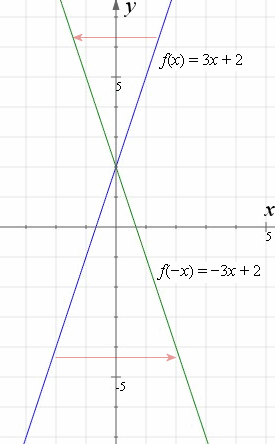
Note that the effect of the "minus" in f(−x) is to reflect the blue original line (y = 3x + 2) in the y-axis, and we get the green line, which is (y = −3x + 2). The green line also goes through 2 on the y-axis.
Further Example
Here's an example using a cubic graph.
Blue graph: f(x) = x3 − 3x2 + x − 2
Reflection in x-axis (green): −f(x) = −x3 + 3x2 − x + 2
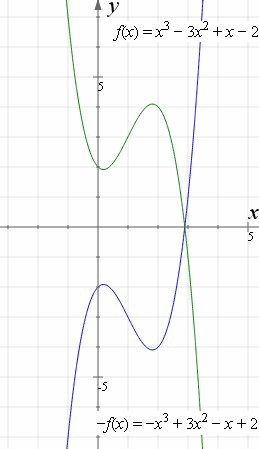
Now to reflect in the y-axis.
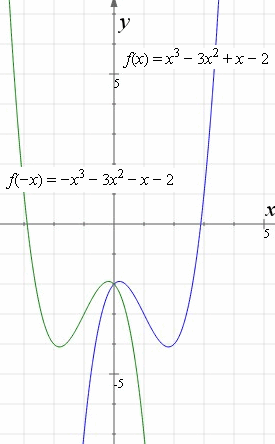
Blue graph: f(x) = x3 − 3x2 + x − 2
Reflection in y-axis (green): f(−x) = −x3 − 3x2 − x − 2
Even and Odd Functions
We really should mention even and odd functions before leaving this topic.
For each of my examples above, the reflections in either the x- or y-axis produced a graph that was different. But sometimes, the reflection is the same as the original graph. We say the reflection "maps on to" the original.
Even Functions
An even function has the property f(−x) = f(x). That is, if we reflect an even function in the y-axis, it will look exactly like the original.
An example of an even function is f(x) = x4 − 29x2 + 100
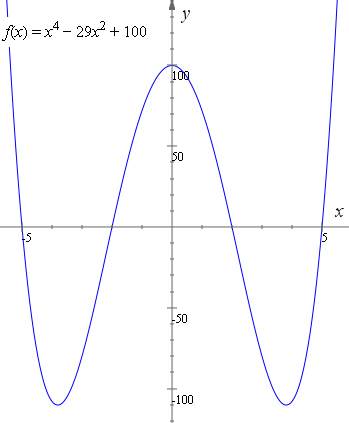
The above even function is equivalent to:
f(x) = (x + 5)(x + 2)(x − 2)(x − 5)
Note if we reflect the graph in the y-axis, we get the same graph (or we could say it "maps onto" itself).
Odd Functions
An odd function has the property f(−x) = −f(x).
This time, if we reflect our function in both the x-axis and y-axis, and if it looks exactly like the original, then we have an odd function.
This kind of symmetry is called origin symmetry. An odd function either passes through the origin (0, 0) or is reflected through the origin.
An example of an odd function is f(x) = x3 − 9x
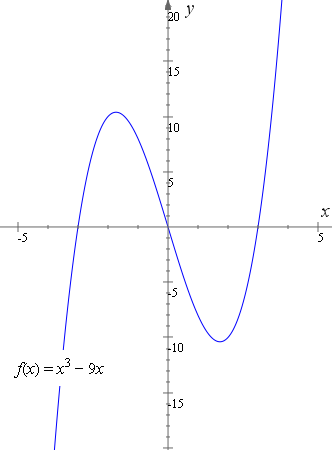
The above odd function is equivalent to:
f(x) = x(x + 3)(x − 3)
Note if we reflect the graph in the x-axis, then the y-axis, we get the same graph.
More examples of Even and Odd functions
There some more examples on this page: Even and Odd Functions
Knowing about even and odd functions is very helpful when studying Fourier Series.
I hope that all makes sense, Stuart.
See the 8 Comments below.

1 Jul 2011 at 12:23 am [Comment permalink]
Small correction: an odd function passes through the origin if and only if zero is in the domain of the function!
In general though, this is a great discussion to bring up. Students and teachers alike have problems navigating this subject and the intuitions aren't usually taught. There's some simple reasoning involved, but students just want to follow a rule more often then not. Thanks for the great post!
2 Jul 2011 at 6:29 am [Comment permalink]
@John: Thanks for the correction! I have amended the post.
28 Jul 2011 at 12:17 am [Comment permalink]
A really good presentation and great help to students.
22 Jan 2014 at 9:44 am [Comment permalink]
Like can u reflect from quadrant 1 into quadrant 3?!?!
22 Jan 2014 at 11:19 am [Comment permalink]
@Sal: The last example in the article does just that - the portion that was in Quadrant 1 is now in Quadrant 3.
24 Sep 2020 at 12:56 am [Comment permalink]
Good day
We know that the product of the gradients of perpendicular lines will always be -1.
I have a question about REFLECTING straight lines.
Am I correct in saying that for straight lines the product of the original line's gradient and the reflected line's gradient will ALWAYS be -1 as well?
And that then means that there are two instances where the product of the gradients of two straight lines will result in -1?
The problem being that a straight line and its reflection will not always be perpendicular to each other.....
Am I missing something?
Kind regards
8 Oct 2020 at 10:50 pm [Comment permalink]
The function f(x) = 2x is stretched 3 times its original size and reflected across the x -axis? would it change to f(x) = -6x? or would it stay positive?
28 Oct 2020 at 6:38 am [Comment permalink]
Thanks, this is really helpful as I have had trouble understanding reflections through the y-axis.You have no idea how much this has helped me.